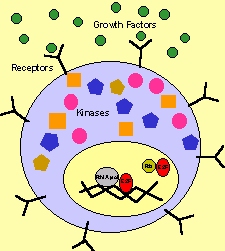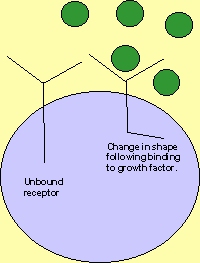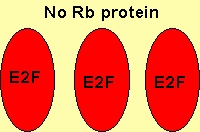
Normally, cells divide only when an organism is growing, to repair an injury or for replacement of old cells. However, when cells divide continuously (unnecessarily) the cells begin to pile up and form a tumor. We are interested in learning how cells normally know when to divide and when not to divide because it is the disruption of the normal growth controls that result in inappropriate cell division.
Generally, a cell receives a chemical signal that "tells" it to divide. For example, when a person cuts themself, the cells near the injury secrete a chemical called a growth factor that signals other nearby cells to divide and repair the damage.
Only cells with an appropriate receptor molecule on their surface can detect the chemical signal.

When the growth factor binds to a receptor, the shape of the receptor molecule on the inside of the cell changes. This change indicates to proteins inside the cell, (some are called kinases), that the signal is received.


Then, through a complex pathway that is not completely understood, the signal reaches the nucleus. It is in the nucleus that proteins called transcription factors activate genes involved in cell division. E2F (see below) is an example of a transcription factor that is involved in cell division.
When cells are not dividing, E2F is bound tightly to another protein called Rb.
When the two proteins are attatched, the E2F is inactive and cannot act to induce cell division. When a cell needs to divide, the shape of Rb changes and it releases E2F. 
Now E2F can activate genes that will allow the cell to divide.

Up until now, everything discussed applies to normal cells. It is when these controls are disrupted that cancer can result.
For example, imagine a situation where a nearby cell continuously secretes growth factors even when there is no injury. All of the surrounding cells that contain receptors will receive a signal to divide when it is not necessary. The result is that a lot of cells are dividing and there is no room for the new cells.
Imagine another situation in which the receptor molecules of a cell have been mutated so now they are ALWAYS in the "active" shape even when growth factors are not around. The result is that the interior of the cell receives the signal to divide.

Try to predict what happens when a cell loses the ability to make the Rb protein. Now, the E2F transcription factor will constantly activate genes to make the cell divide. Loss of the Rb protein commonly occurs in a tumor of the eye called Retinoblastoma (hence the name Rb).


Genes are comprised of DNA (see heredity section). DNA can be mutated by chemicals, radiation, and by cellular enzymes during replication of DNA.
The number one known chemical carcinogen is tobacco smoke. There are many chemicals in tobacco smoke that are known to mutate DNA. In addition, the smoke is very harmful to the cells in the lung and they are continually injured from the smoke. These two factors combine to make smoking very dangerous. One in three people that smoke will eventually develop lung cancer (and many more will succumb to other lung ailments).
Diet affects cancer risk. It is not clear exactly how diets high in fat and in calories increase risk of cancer but several epidemiological studies point towards these factors as likely candidates for increasing cancer risk.
Ultraviolet light and X-rays can also increase cancer risk as they directly mutate DNA. Sunburns should be avoided especially at a young age. Diagnostic X-rays have very low levels of radiation and can be extremely useful, however, it is a good practice to cover the parts of the body that are not being X-rayed with a lead covering.